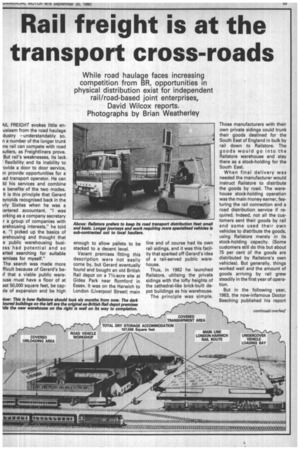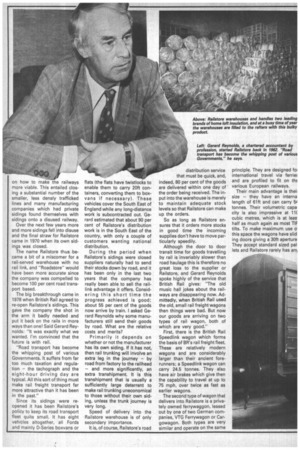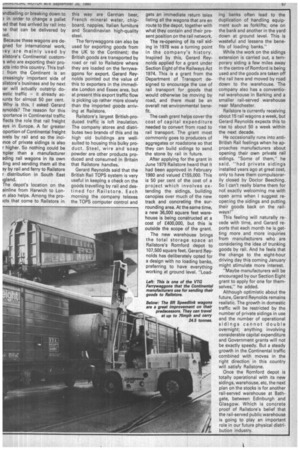Rail freight is at the transport cross-roads
Page 67

Page 68

Page 69

If you've noticed an error in this article please click here to report it so we can fix it.
4IL FREIGHT evokes little enusiasm from the road haulage dustry —understandably so. n a number of the longer trunk Ins rail can compete with road iuiiers, as Freightliners prove. But rail's weaknesses, its lack. flexibility and its inability to .ovide a door to door service, in provide opportunities for a lad transport operator. He can Id his services and combine e benefits of the two modes. It is this principle that Gerard ayrrolds recognised back in the irly Sixties when he was a iartered accountant. "I was orking as a company secretary r a group of companies with arehousing interests," he told e. "I picked up the basics of arehousing and thought that e public warehousing busi3ss had potential and so arted searching for suitable emises for myself."
The search was made more fficult because of Gerard's beif that a viable public ware)use must have a floor of at ast 50,000 square feet, be cap)le of expansion and be high enough to allow pallets to be stacked to a decent level.
Vacant premises fitting this description were not easily come by, but Gerard eventually found and bought an old British Rail depot on a 71/2-acre site at Gidea Park near Romford in Essex. It was on the Harwich to London (Liverpool Street) main line and of course had its own rail sidings, and it was this facility that sparked off Gerard's idea of a rail-served public warehouse.
Thus, in 1962 he launched Railstore, utilising the private sidings with the lofty heights of the cathedral-like brick-built depot buildings as his warehouse.
The principle was simple. Those manufacturers with their own private sidings could trunk their goods destined for the South East of England in bulk by rail down to Railstore. The goods would go into the Railstore warehouse and stay there as a stock-holding for the South East.
When final delivery was needed the manufacturer would instruct Railstore to distribute the goods by road. The warehouse stock-holding operation was the main money earner, featuring the rail connection and a road distribution service if required. Indeed, not all the customers sent their goods by rail and some used their own vehicles to distribute the goods, using Railstore merely in its stock-holding capacity. (Some customers still do this but about 75 per cent of the goods are distributed by Railstore's own vehicles). But generally, things worked well and the amount of goods arriving by rail grew steadily in the first year of operation.
But in the following year, 1963, the now-infamous Doctor Beeching published his report on how to make the railways more viable. This entailed closing a substantial number of the smaller, less densly trafficked lines and many manufacturing companies which had private sidings found themselves with sidings onto a disused railway.
Over the next few years more and more sidings fell into disuse and the final straw for Railstore came in 1970 when its own sidings was closed.
The name Railstore thus became a bit of a miscomer for a rail-served warehouse with no rail link, and "Roadstore" would have been more accurate since the company was compelled to become 100 per cent road transport based.
The big breakthrough came in 1978 when British Rail agreed to re-open Railstore's sidings. This gave the company the shot in the arm it badly needed and put it back on the rails in more ways than one! Said Gerard Reynolds: "It was exactly what we wanted. I'm convinced that the future is with rail.
"Road transport has become the whipping post of various Governments. It suffers from far too much taxation and regulation — the tachograph and the eight-hour driving day are typical. All this sort of thing must make rail freight transport far more attractive than it has been in the past."
Since its sidings were reopened it has been Railstore's policy to keep its road transport fleet quite small. It has eight vehicles altogether, all Fords and mainly D-Series boxvans or flats (the flats have twistiocks to enable them to carry 20ft containers, converting them to boxvans if necessary). These vehicles cover the South East of England while any long-distance work is subcontracted out. Gerard estimated that about 90 per cent of Railstore's distribution work is in the South East of the country, with only a couple of customers wanting national distribution.
During the period when Railstore's sidings were closed suppliers naturally had to send their stocks down by road, and it has been only in the last two years that the company has really been able to sell the raillink advantage it offers. Considering this short time the progress achieved is good; about 55 per cent of the goods now arrive by train. I asked Gerard Reynolds why some manufacturers still send their goods by road. What are the relative costs and merits?
Primarily it depends on whether or not the manufacturer has its own siding. If it has not, then rail trunking will involve an extra leg in the journey — by road from factory to the railhead — and more significantly, an extra transhipment. It is this transhipment that is usually a sufficiently large deterrent to make rail trunking uneconomical to those without their own siding, unless the trunk journey is very long.
Speed of delivery into the Railstore warehouse is of only secondary importance.
It is, of course, Railstore's road distribution service that must be quick, and, indeed, 80 per cent of the goods are delivered within one day of the order being received. The input into the warehouse is merely to maintain adequate stock levels so that Railstore can make up the orders.
So as long as Railstore ensures that it orders more stocks in good time the incoming supplies don't have to move particularly speedily.
Although the door to door transit time for goods travelling by rail is invariably slower than road haulage this is therefore no great loss to the supplier or Railstore, and Gerard Reynolds spoke highly of the service that British Rail gives: "The old music hall jokes about the railways are disappearing now. Admittedly, when British Rail used the old, small rail freight wagons then things were bad. But now our goods are arriving on two types of rail wagon, both of which are very good."
First, there is the British Rail Speedlink wagon which forms the basis of BR's rail freight fleet. These are relatively modern wagons and are considerably larger than their ancient forerunners; a Speedlink wagon can carry 24.5 tonnes. They also have air brakes which give then the capability to travel at up to 75 mph, over twice as fast as earlier wagons.
The second type of wagon that delivers into Railstore is a privately owned ferrywaggon, leased out by one of two German companies, VTG Ferrywagon or Cargowagon. Both types are very similar and operate on the same principle. They are designed fol international travel via ferrie and are profiled to fit on the various European railways.
Their main advantage is theil size — they have an interne length of 61ft and can carry tonnes. Their volumetric capa city is also impressive at VIC cubic metres, which is at leas half as much again as most TIE tilts. To make maximum use o this space the wagons have slid ing doors giving a 30ft aperture They accept standard sized pal lets and Railstore rarely has an) 3ndballing or breaking down to 3 in order to change a pallet ad that has arrived by rail into ie that can be delivered by
Because these wagons are degned for international work, ley are mainly used by ailstore's Continental customs who are exporting their proJcts into this country. This traf; from the Continent is an creasingly important side of ailstore's business and by next ar will actually outstrip doestic traffic — it already ac)unts for almost 50 per cent. Why is this, I asked Gerard aynolds? The reason for this iportance in Continental traffic flects the role that rail freight ays in Europe. A far greater °portion of Continental freight )vels by rail and so the inciince of private sidings is also r higher. So nothing could be Tyler than a manufacturer ading rail wagons in its own ding and sending them all the ay by rail and ferry to Railstore r distribution in South East 'gland.
The depot's location on the ainline from Harwich to Lonin also helps. Among the proicts that come to Railstore in this way are German beer, French mineral water, chipboard, nappies, Italian furniture and Scandinavian high-quality steel.
The ferrywaggons can also be used for exporting goods from the UK to the Continent; the British goods are transported by road or rail to Railstore where they are loaded on the ferrywaggons for export. Gerard Reynolds pointed out the value of this to exporters in the immediate London and Essex area, but at present this export traffic flow is picking up rather more slowly than the imported goods arriving at Railstore.
Railstore's largest British-produced traffic is loft insulation. The company stores and distributes two brands of this and its high old buildings are wellsuited to housing this bulky product. Steel, wire and soap powder are other products produced and consumed in Britain that Railstore handles.
Gerard Reynolds said that the British Rail TOPS system is very useful in keeping a check on the goods travelling by rail and destined for Railstore. Each morning the company telexes the TOPS computer control and gets an immediate return telex listing all the wagons that are en route to the depot, together with what they contain and their present position on the rail network.
The re-opening of its rail siding in 1978 was a turning point in the company's history. Inspired by this, Gerard Reynolds applied for a grant under Section Eight of the Railways Act 1974. This is a grant from the Department of Transport designed to encourage the use of rail transport for goods that would otherwise be moving by road, and there must be an overall net environmental benefit.
The cash grant helps cover the cost of capital expenditure needed to convert from road to rail transport. The grant most commonly goes to producers of aggregates or roadstone so that they can build sidings to send the stone by rail in future.
After applying for the grant in June 1979 Railstore heard that it had been approved in February 1980 and valued £155,000. This is 50 per cent of the cost of a project which involves extending the sidings, building canopies over much of the new track and concreting the surrounding area. At the same time, a new 36,000 square feet warehouse is being constructed at a cost of £400,000, but this is outside the scope of the grant.
The new warehouse brings the total storage space at Railstore's Romford depot to 107,500 square feet. Gerard Reynolds has deliberately opted for a design with no loading banks, preferring to have everything working at ground level. "Load ing banks often lead to the duplication of handling equipment such as forklifts; one on the bank and another in the yard down at ground level, This is wasteful and lessens the benefits of loading banks."
While the work on the sidings extension is carried out, a temporary siding a few miles away in the centre of Romford is being used and the goods are taken off .the rail here and moved by road down to the warehouse. The company also has a conventional warehouse in Barking and a smaller rail-served warehouse near Manchester.
Railstore is currently receiving • about 15 rail wagons a week, but Gerard Reynolds expects this to rise to about 50 a week within the next decade.
He occasionally runs into antiBritish Rail feelings when he approaches manufacturers about opening their own private rail sidings. "Some of them," he said, "had private sidings installed years ago at great cost, only to have them compulsorarily closed by Doctor Beeching. So I can't really blame them for not exactly welcoming me with open arms when I suggest reopening the sidings and putting their goods back on the railways!"
This feeling will naturally recede with time, and Gerard reports that each month he is getting more and more inquiries from manufacturers who are considering the idea of trunking goods by rail. And he feels that the change to the eight-hour driving day this coming January might stimulate more interest.
"Maybe manufacturers will be encouraged by our Section Eight grant to apply for one for themselves," he added.
Although optimistic about the future, Gerard Reynolds remains realistic. The growth in domestic traffic will be restricted by the number of private sidings in use and the number of operational sidings cannot double overnight; anything involving considerable capital expenditure and Government grants will not be exactly speedy. But a steady growth in the Continental traffic combined with moves in the right direction in this country will satisfy Railstone.
Once the Romford depot is totally operational with its new sidings, warehouse, etc, the next plan on the stocks is for another rail-served warehouse at Bath gate, between Edinburgh and Glasgow. Which is concrete proof of Railstore's belief that the rail-served public warehouse is going to play an important role in our future physical distribution industry.






























































































































